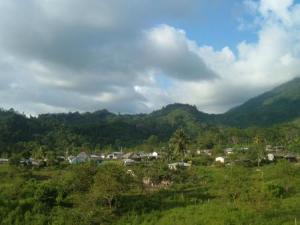Analyzing Civil War and Local Peacebuilding at S-CAR
Analyzing Civil War and Local Peacebuilding at S-CAR
 Interest in local peace zones, local peace communities and local peace-building actually started at ICAR – as it then was – as the result of a visit that Dennis Sandole and I (plus one doctoral student) paid to a small town on the Armenian side of the border with Azerbaijan in the early 1990s. The Soviet Union had just collapsed, several of that Union’s constituent republics had obtained their independence, and, on independence, Armenia and Azerbaijan had taken to fighting sporadically but lethally over a chunk of Azerbaijan known as Ngorno Karabakh, which Armenians claimed should rightfully belong to Armenia as it had an overwhelmingly Armenian population. At the time there was a precarious truce, Armenia was desperately short of power because an earthquake had damaged and shut down their nuclear power plant, and the State University of Yerevan, our host, was continuing to teach courses with the greatest of difficulty.
Interest in local peace zones, local peace communities and local peace-building actually started at ICAR – as it then was – as the result of a visit that Dennis Sandole and I (plus one doctoral student) paid to a small town on the Armenian side of the border with Azerbaijan in the early 1990s. The Soviet Union had just collapsed, several of that Union’s constituent republics had obtained their independence, and, on independence, Armenia and Azerbaijan had taken to fighting sporadically but lethally over a chunk of Azerbaijan known as Ngorno Karabakh, which Armenians claimed should rightfully belong to Armenia as it had an overwhelmingly Armenian population. At the time there was a precarious truce, Armenia was desperately short of power because an earthquake had damaged and shut down their nuclear power plant, and the State University of Yerevan, our host, was continuing to teach courses with the greatest of difficulty.
After a large and lavish dinner, with many toasts, the local mayor – a formidable and impressive lady – arose and announced that she and her opposite number in the town across the border in Azerbaijan, who had been a friend and colleague until just a few years ago, were thinking of establishing a peace zone along their mutual border “…to prevent accidents, to control armed clashes and to build bridges between local people who until recently had been neighbours…” She was sure that the experts from George Mason University’s conflict and peace programme would have some useful ideas to offer.
Fortunately, the doctoral student we had with us was Lt Colonel Moorad Mooradian, U.S. Army (Retd.), who proceeded to save ICAR’s - and our - reputation by making a number of sensible and practical suggestions for setting up a local peace zone as a tranquil “buffer” along what had recently become a contentious, international border. However, as Dennis and I drove back from the mountains towards Yerevan, we agreed that we had to find out if anyone at ICAR was working on or knowledgeable about peace zones and how they worked.
As it turned out, there wasn’t - so I asked my then- GRA, Susan Allen, to start making arrangements for a conference at ICAR that would involve scholars and practitioners who could talk about zones of peace and give us ideas about their nature, varieties, and effectiveness. The conference duly took place about a year and a half later and involved a huge variety of knowledgeable people who came and talked about their experiences with peace “zones,” small, medium and large, locally or nationally initiated, territorially or communally based. Among the participants were Robert Gravelle, who had helped to establish the Ledra Palace Hotel on the Green Line in Nicosia as neutral and peaceful ground; Indian Major General Indar Jit Rikye who had set up “the Rikye” safe zone amid the first civil war in the Congo in 1963 and then gone on to found the International Peace Academy (IPAC) in New York to study peacekeeping forces; Liam Mahoney, the expert on protective accompaniment for local individuals and organizations directly threatened with violence; Professor Ed Garcia, originally from the Philippines and knowledgeable about local peace communities there and in Colombia; and then-ICAR Director, Kevin Clements, who discussed the record of nuclear weapons free zones. A student research assistant was then assigned to each speaker to help produce a joint article and the results were finally published in June 1997 in the journal Peace Review.
What next? Coincidentally, at that time ICAR started to receive a cohort of bright and active doctoral and masters students from Latin America - Catalina Rojas, Beatriz Vejarano and (a bit later) Mery Rodriguez, all from Colombia, as well as Giselle Ober from Peru, Adriana Salcedo and Maria Dolores Rodriguez both from Ecuador, and Yves Renee Jennings from Haiti. All of them wanted to know why ICAR was doing so little work in and on Latin America, while the Colombia students were already aware of a large number of local peace communities and violence free zones that existed amid the long drawn out civil war in their own country. There was some mention of the work of a Colombian umbrella organisation, REDEPAZ (Network of Initiatives for Peace and against War) that was trying to coordinate, extend and reinforce the activities of some of the pioneering peace communities in Colombia – La India, Mogotes, Samaniego, San Jose de Apartado.
REDEPAZ had just been given a 2-year grant by the EU - later extended by another 4 years - to support their project "100 Municipalities of Peace” and was hosting an organizing conference of peace communities in Bogota in the Fall of 1999. I managed to wangle myself an invitation to this meeting, met many of the brave and determined campesinos and others who were trying to create islands of peace amid a vicious, three sided civil war, and talked with Ana Teresa Bernal, the dedicated Director of REDEPAZ. I came back to ICAR thinking that we might help by surveying and analyzing this local activity aimed at establishing peace zones in Colombia, as well as in other strife torn countries. Could useful lessons be learned?
From this thought, and with the support of faculty such as Kevin Avruch and Wallace Warfield, emerged the Local Zones of Peace Working Group (ZoPWG) consisting of most of our Latin American students and many others who were interested in the topic, often as one aspect of their dissertation work, among them Pushpa Iyer, originally from Gujerat but interested in zones of peace in Mindanao; Landon Hancock, working on his dissertation about Northern Ireland; Bobby Jose from the Philippines; Krista Rigalo and Nancy Morrison who had both worked in the Sudan and were interested in peace “corridors” for delivering food and medical supplies to civilians; and Jennifer Langdon, already teaching on the Criminal Justice Program at Towson University but willing to help write about Peru and the Rondas Campesinas there. We were also fortunate in obtaining a small grant from USIP to support the work and this enabled us to employ a Colombian anthropologist, Sara Ramirez, as a field worker to undertake interviews, although the dangers of such work became evident when one of the local paramilitary groups accused her of being a guerrilla agent and she had to leave the country and spend a year at ICAR working directly with ZoPWG.
So that was how ICAR became interested in local peace zones and communities. As with many ICAR projects and programs, the ZoPs Working Group arose from the shared interests of a group of faculty and students and their willingness to spend scarce and valuable time and effort on the program, even though it was not part of the formal course work, even though nobody gained 1, 2 or 3 credits for the work, and even though it took participants away from outside work, family, courses, and writing. I can only hope the rest of the Group gained as much knowledge and insight about conflict analysis and resolution as I did – and enjoyed it as much.
###Photo - San José de Apartadó, one of the more well known zones of peace. Taken by Thomas Flores




